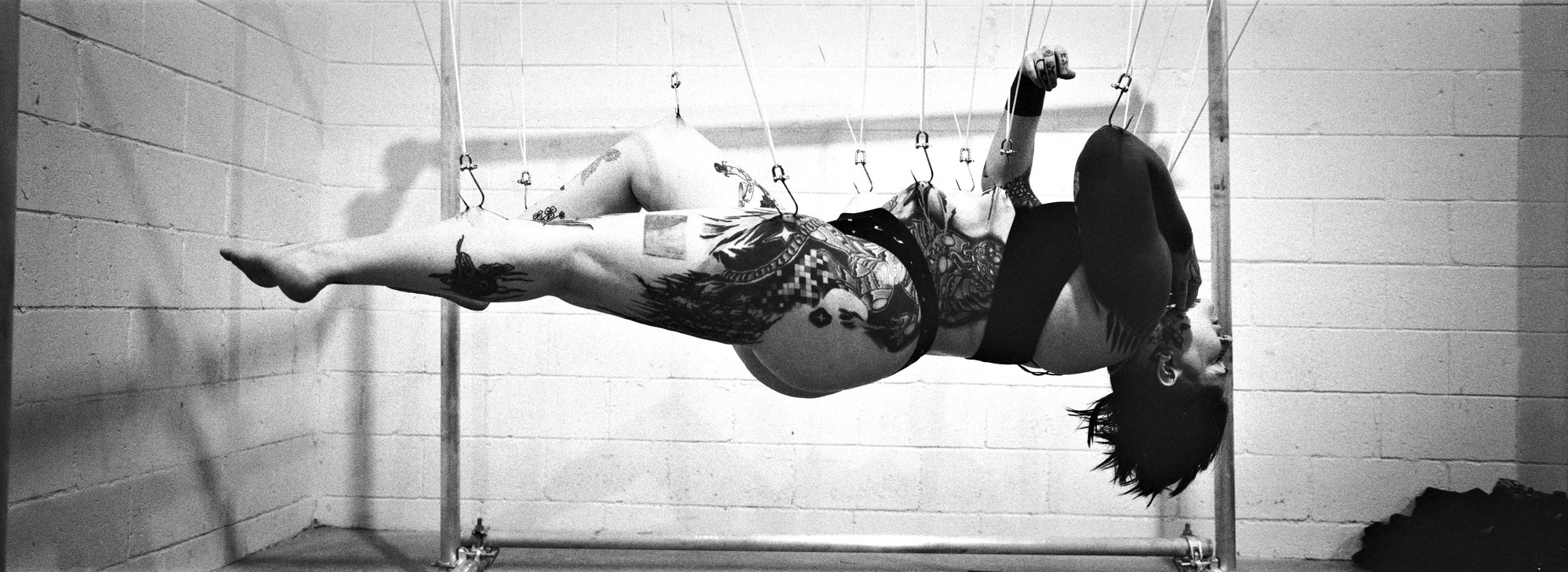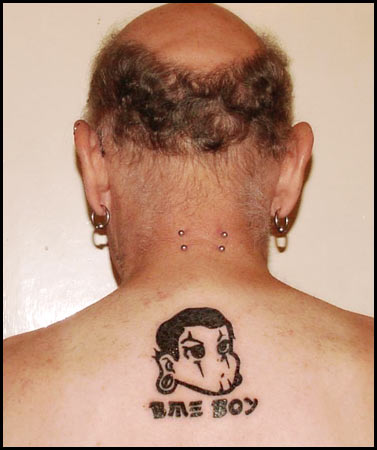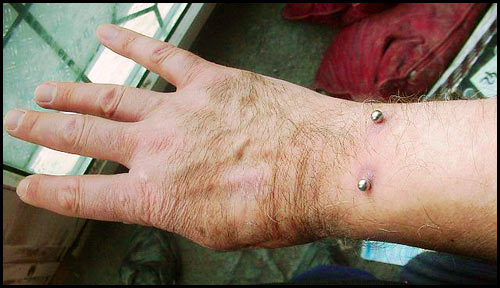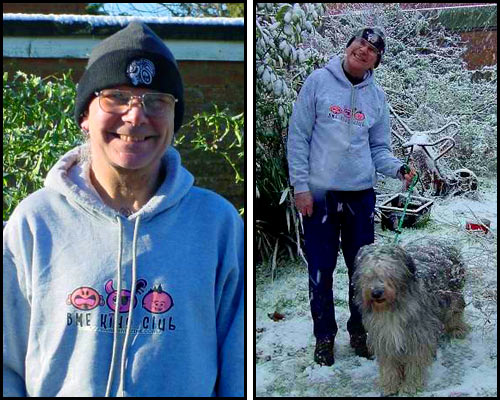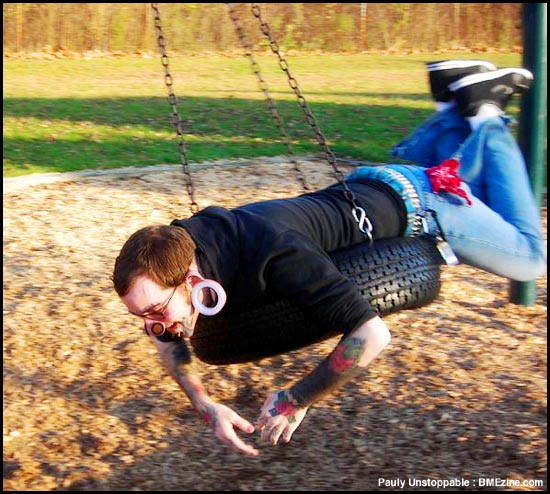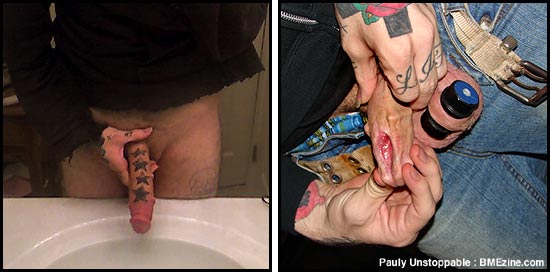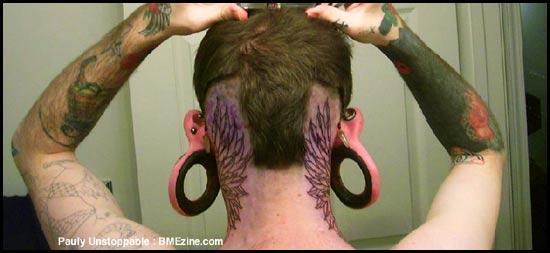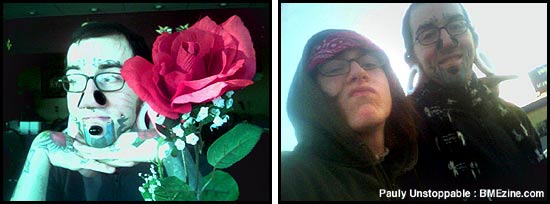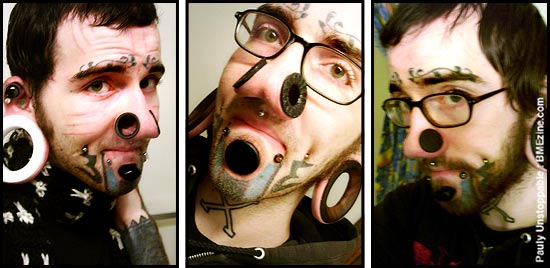Billy writes,
“I dont think it’s a bad idea, just one that should be considered carefully as compared to stretching it’s far more permanent. After the procedure the lowest gauge I can achieve by “shrinking” alone is about 5/8″, if it had been stretched as opposed to scalpelled I would be able to reach a much lower gauge. There are reconstructive options available to me but that is a whole other world! This particular procedure had many problems, mostly caused by inexperience..
I discussed the procedure at length with the practitioner, as I had already planned how I wanted it to happen. I’d have done it myself but wasn’t able to work on my own ears.
So I laid down on the table and a few small slits were made to my lobe, they then tried to force the jewellery into my ear (I asked why this method was being used and was told they didn’t have tapers large enough). A small piece of skin was then removed and more forcing ensued. She then exclaimed “Wow, I just noticed how much bigger this one really is!”
Now I’m scared. I should have stood up right then but I was already bleeding.. “Keep going” she says, “Bite your tongue, you’re gonna feel all of this.” Then, using a sawing motion with her #15 scalpel (I had requested a #21 because she was small and I was worried about her wrists not being strong enough) she hacked out a blob of skin and tried to force the plug in again, still not enough room.
One more go and another blob of skin later and with enough force she managed to get it in there, it was immensely more painful than it had to be that’s for sure! All in all it took about 25 minutes and I bled A LOT.
Before I knew it the combination of adrenaline and blood lust had me agreeing to let her do the other one?!
She says “I know how much skin I have to remove now so the second one won’t be so bad”. She was right, she made two cuts to remove a triangular piece of flesh, it wasn’t quite enough but she forced that sucker in there anyway.. this time it took about 10 minutes.
My healing was slow and gruesome, it looked like hamburger for the first couple of days, the jagged portions of the “hamburger” died and fell away eventually. One of the wounds had deep exposed areas, exposing blood vessels and causing it to bleed for the first week and half, the other lobe only bled for a few days because that one was cut only enough to allow them to be forced in. The combination of stretching and cutting made the “pressure” part of the pain immense for the first week. The stretched parts formed small water blisters that I dealt with using sea-salt soaks.
The body can recover from many things, and now the only problem is a large blow-out on my right lobe in a spot too thin to “trim” it. When I take the plugs out the resulting hole is kind of triangular/a jagged tear-drop shape.
Ear scalpelling is somthing that I’ve worked down to a science! By taking the gauge a person is currently wearing, and the gauge of the new jewellery – a simple equation can give you the area that must be removed.
With the required area attained using that equation a second more complicated equation and a graphing calculater can give you a “bilateral arc” in the shape of the area that needs to be removed, this is then traced on the ear by visually identifying the best spot on the lobe (taking care to avoid any cartilage structure). When removing this skin instead of a flat A to B style cut you start from the front about two to three millimetres below the traced area (more or less, depending on the thickness of the earlobe) and cut upwards so the exit of the incision on the back of the ear is in line with your tracing, thus removing a triangular strip of flesh.
After that’s done you begin tapering (again from the front), this forces that small extra piece of skin you left behind over the wound, thus closing it. It acts as a fistula made of skin. I have seen amazing healing times with this procedure. Sea-salt for a week or two after and you’re good to go!
The procedure I’ve just detailed came from a lot of trial, I wouldn’t be surprised if other people use it as well (I live in nowhereland on the edge of Canada and I’m kinda secluded I think).
The key is a steady hand and good planning.”
* * *
Here’s what a few other practitioners have to say after watching the video..
Patrick Bartholomew
“I would have simply clamped them with mosquito forceps and then cut along the clamp mark – Quicker, easier and far more accurate than using the method shown.”
Pauly Unstoppable
“Well, up until the end it wasn’t so bad, although it showed they had absolutely no idea what they were doing. They had no grasp on the concept of sizing the cut for the jewellery they were putting in, and for that sort of thing I would have removed a little bit of tissue (not just a single cut), any other way would lead to more problems later on. On top of that they were putting what looks like HORN into the lobe, which is by far the dumbest thing you can do with a fresh piercing! I never under any circumstance would recommend putting any kind of organic jewellery into a fresh piercing, especially a freshly cut lobe.
Organic materials are porous and will soak up any discharge and basically rot away which can lead to really bad infections and such.”
Tye
“On a personal level I wouldn’t be using iodine/betadine to prepare the tissue due to the whole shellfish allergy aspect, and if I was forced to use it I would go for alcohol followed by iodine/betadine and then alcohol to remove the orange tint from the tissue so it wouldn’t get into the actual working area.
These products are ok for prepping, but on tissue that is healing these products can be very damaging. Also, only the lobe itself has been prepped and not the surrounding tissue/ear, which you notice she is touching constantly.
It seems this person doesn’t understand the math behind lobe scalpelling.. I really don’t see a need for removing and resetting the clamps. She should just be able to make two cuts (maximum of three) and then do the stretch.. There also doesn’t seem to be any method to her cutting. It looks as though she hasn’t planned anything out and is just removing tissue until the plug fits.. I’m curious if she actually got it in the lobe!
The main thing I’m seeing is she’s not using a taper to put tension on the tissue. She’s just trying to ram double flared plus in… not only is this going to cause tearing but it looks like a buffalo horn based plug which is VERY porous and will only cause further problems. Not to mention – Organic material can’t be sterilized. To me the size she’s trying to get to from where this person is at won’t work with the tissue that is there, full stop.
The “artist” isn’t using anything to stablize the tissue she’s cutting which is just going to make it difficult to cut as well as leave a huge margin for error. She’s also wearing a bracelet which is pretty dirty in my eyes. It’s chain based which can and will collect all sorts of fluid and spores.
The constant removal of the clamps isn’t going to allow the tissue to sit naturally and the shifting could cause a double cut and change the angle which the cut was made.
Finally, it looks as though that person might be at 1/2″ and the plug he’s trying to ram in there is at least an 1″ or more!”
Tom Brazda
“Firstly, that kind of jewellery is not suited for a scalpelling, it looks like it’s horn. Organics are porous (ROO – Recurring theme!) and can absorb blood and lymph from the wound, plus they can’t be sterilized. Also it’s obviously too big, there is a limit to how much of a stretch that can achieved with scalpelling and most the time your only going to go up two sizes.
A simple slit is not enough, a triangular piece of tissue needs to be removed at the very least. The piece removed needs to be done in such a way that the new hole retains a smooth outer apearance. A simple slit leaves two points along the new edge and all that happens is that these fold outwards.
Oh ya, and they don’t know what they are doing!”
Russ Foxx
“A few things I saw that I don’t agree with:
1: The jewellery is not something I would use due to the double flares.
2: The jewellery is much too large of a jump from where he was in the first place.
3: The cuts were placed in bad spots. I’d never cut the bottom of a lobe, let alone cut one in more than one spot.
4: Tapers and single flare jewelry would have made much more sense.”

